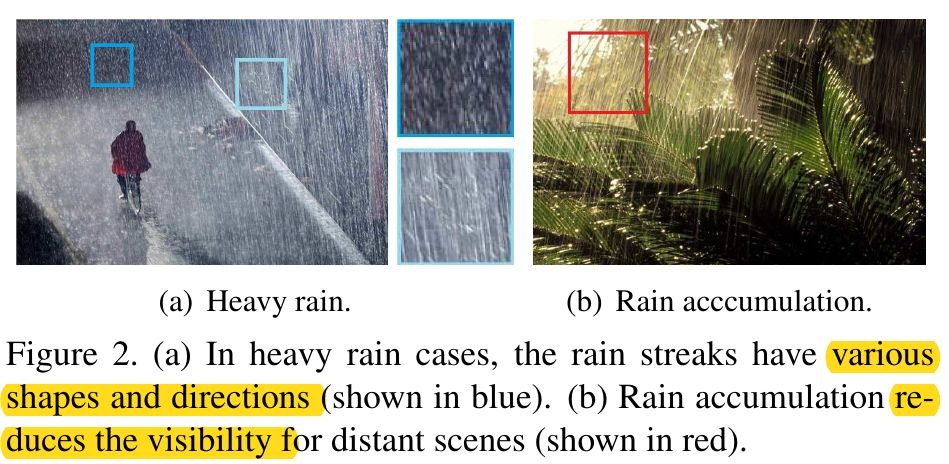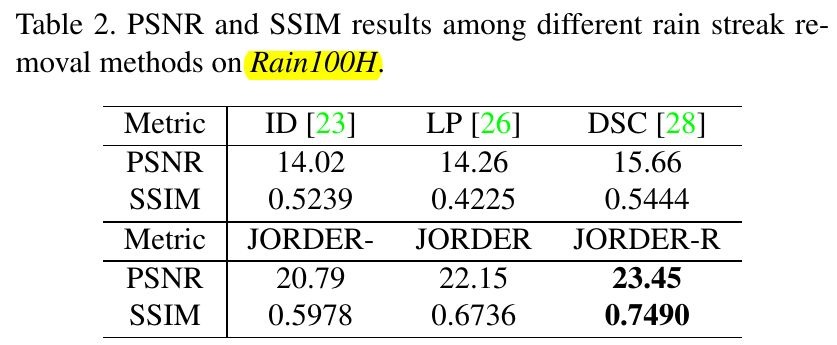Yang W, Tan R T, Feng J, et al. Deep joint rain detection and removal from a single image[C]//Proceedings of the IEEE Conference on Computer Vision and Pattern Recognition. 2017: 1357-1366.
1. Overview
现实生活中的雨滴具有以下特性
- 远处的雨滴堆积产生类似于雾的大气遮盖物,散射光线,导致可见度降低
- 近处的雨滴产生镜面反射,遮挡背景
- 雨滴具有不同形状和方向. 尤其是大雨,可见度很低
现有的方法存在一些不足之处
- 雨滴与背景纹理存在重叠,去雨导致over-smoothing the regions
- 雨滴的退化效果很复杂,现有方法不能充分包含所有重要的因素
- 基于local patch或有限receptivefield
因此,论文
- 对雨滴进行建模
- 创建数据集Rain100H
- 并在此基础上提出multi-task深度学习框架
1.1. Contribution
- First method to model rain-streak binary mask, atmosphere veils and various shapes and directions of overlapping rain streaks
- First method to jointly detect and remove rains
- First rain method to use contextualized dilated network
- First method use recurrent to address heavy rain
1.2. 相关工作
- Sparse coding. Learned dictionary
- Low rank
- Non-local mean filter
- Discriminative sparse coding
- GMM
- Denoising, complement, super-resolution, deblurring, deconvolution, style tansfer, dehazing, light enhancement.
1.3. 数据集
数据集中的图片选择BSD200
- Rain12, Rain100L. one type of rain streak
- Rain100H (论文提出). five type of rain streak,虽然现实生活中很少同时存在多种类型的rain streak. 但这样的训练数据能够提升网络性能

d. simulated sharp line streaks along a certain direction with a small variation
2. Rain Image Model
2.1. Widely Used Model
此前的一些工作用

表示rain image model. 将rain removal转化为分离两个信号问题.
- O. Input image or Observe image
- B. Background layer
- S. rain streak layer
但该模型存在缺陷 - 不同region中的S具有不同的密度,无法使用统一的S表示
- 没有区分rain region和no-rain region,造成no-rain region过度平滑
2.2. Region-dependent Model

R为binary mask. 1表示rain region. 0表示no-rain region.
公式表明
- 提供额外gt (rain streak region)给神经网络模型. Multi-task
- pipeline. 检测rain region, 对rain region和no-rain region进行不同的处理
2.3. Rain Accumulation Model
雨滴存在堆积的情况,并形成类似与雾的视觉效果。

Koschmieder模型适用于近似多种浓密的介质,如雾、水下等。因此,可将模型表示为

- t. rain-streak layer index
- s. rain-streak layer number
- A. global atmosphere light
- α. atmosphere transmission
公式表明:可独立处理rain removal和rain accumulation

3. Architecture
3.1. Joint Rain Streak Detection and Removal (JORDER)

结构
- 通过Contextualized Dilated Network提取特征F
- 基于F预测R
- 基于[F, R]预测S
- 基于[F, R, S]预测SR
- B = O - SR
- Recurrent
也可采用其他的策略:并行预测等。
3.2. Contextualized Dilated Network
- 分支一:Conv 3x3 1 dilate, Conv 3x3 1 dilate, 感知域5x5
- 分支二:Conv 3x3 2 dilate, Conv 3x3 2 dilate, 感知域9x9
- 分支三:Conv 3x3 3 dilate, Conv 3x3 3 dilate, 感知域13x13
3.3. Loss Function

3.4. Recurrent
每次迭代的过程

最终生成图片

τ为迭代次数
- Loss Function

3.5. Rain-Accumulation Removal

虽然公式3表明,首先应做rain-accumulation removal. 但会增强图片中sharp, visible rain streak,导致与数据集中的rain streak不同。因此,论文的处理过程为
- streak removal
- rain-accumulation removal
- streak removal

Accumulation removal网络
- Create another network based on the structure of contextualized dilated network, with only one recurrence
- Trained with the synthesized data generated with the random background reliance and transmission value
4. Experiments
4.1. Baseline
- JORDER-. 只有一条分支,不使用dilated convolutions
- JORDER.
- JORDER-R.
JORDER-R-DEVEIL.
Image Decomposition (ID)
- CNN
- DSC
- Layer Prior (LP)
- SRCNN
4.2. 实验结果


